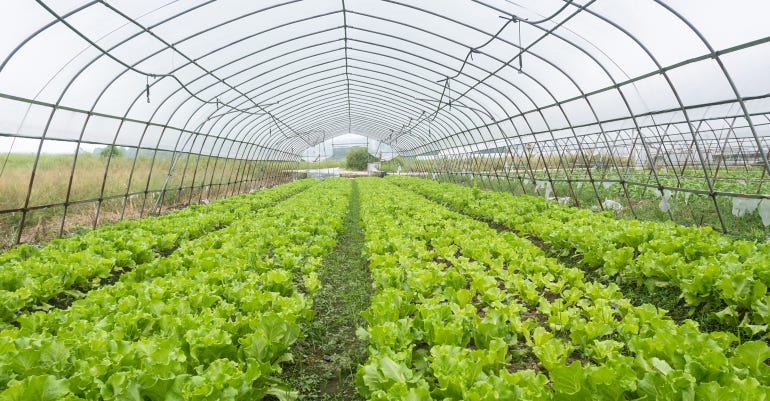
It’s no surprise that Mike Marett, co-owner of Rimol Greenhouse Systems in Hookset, N.H., is a big fan of high tunnels. After all, he sells them.
But he knows they’re not for everyone.
“They are intense, and you need to be a manager,” he said during a presentation at the Mid-Atlantic Fruit and Vegetable Convention in Hershey, Pa.
The key is knowing what you’re growing and marketing, and determining if high tunnels will fit into your system.
“You need to treat a high tunnel as a tool. You need to know what you’re going to be. You need to define yourself,” he said. “Once you do that, you get the tools to do it, and high tunnels are a tool.”
There are many types of high tunnels to choose from, but getting the right-sized system depends on what you are growing and how much you need to produce.
Here are some things to consider before buying and installing a system:
1. Figure out the structure. High tunnels can come in many shapes and sizes, but the most common are single-hoop tunnels, gothic tunnels, movable tunnels and three-season type tunnels.
Gothic tunnels offer more support and are popular in colder climates, he said, because they can handle snow and wind better.
Movable tunnels have wheels that run on either a V-shaped piece of sheet metal or a long tube to make it easier to move.
2. Know the benefits for your farm. When it comes to berries, Marett said a high tunnel can provide many benefits. “Larger berries, longer canes, more fruit clusters. You can implement insect screens or bird protection screens, and you can keep moisture off the fruit. But the big thing is you get a season extension,” he said. “If you can provide berries at a farmers market when nobody else is, that's a market advantage that you have.”
Marett uses a high tunnel to grow tomatoes. He said he gets a 99% yield on his tomatoes growing in a tunnel. They’re sold to premium buyers, including a premium butcher shop and a local taco stand. “You need to find your market niches where you're going to be successful," he said.
3. Figure out the right size. Getting a right-sized system is key to not only growing more crops, but also saving some money. "Before speaking to a high tunnel seller, you need to know the answers to all these questions," he said. “They're going to probably sell you something to make the most money.”
“They should ask you a lot of questions in order to fit what you need,” he said.
High tunnels can be sized any way you like, but Marett said the typical width is 30 feet, “because that gives you the right number of standard beds, to give you a walkway and to maximize the amount of plants you can put in there.”
The sweet spot for length, he said, is 96 feet, “because that’s probably the most effective cooling length. You get longer than that, you might be collecting too much heat in the top.”
The typical truss height is 8 feet, but higher walls can be beneficial. “You want a higher wall because you want to drive a tractor in there, or walk through it,” he said. “Then you can just raise it up. It’s not a problem.”

CONTROLLING ENVIROMENT: Some growers have high tunnels to control the amount of water their plants get, especially if they’re growing a high-value crop.

4. Design tunnel for weather conditions. Snow and wind can persist well into the spring in New York and New England. Marett said bigger steel tubes are stronger, but you still want to look at the gauge rating.
“The lower the gauge, the stronger the steel. A gauge is the number of thicknesses of that steel that will fit within an inch. So if it’s 11 gauge, that means 11 of those thicknesses stacked on top of each other equals an inch,” he said.
Making sure the tunnel has proper bracing is also crucial, he said, as not all manufacturers provide bracing in their kits.
“Some make you pay for them, some only put them every other bow (hoop), some put them on every bow. You can even have wind bracing,” he said.
5. Pick the right roof and ventilation. Roof coverings are usually one or two layers. A one-layer roof is usually held on using tape attached to the hoops. Two-layer covers are inflated using a blower. They can help trap heat at night, he said, and provide a nice slide for snow to come off easily.
Ventilation can consist of simple rollup sides with a gearbox to more sophisticated automated systems.
Knee walls can be useful, he said, because they can prevent plants from getting “shocked” from air flowing in. And ridge vents, while expensive, can allow heat to escape to maintain a consistent temperature in the structure.
In his own tunnel, Marett said he uses three-stage cooling to maintain a constant temperature of 70 degrees F in the spring and summer.
“To maintain 70 degrees, the shutter opens. If it can’t maintain it, the ridge vent opens in 6-inch increments. If that doesn’t work, then the rollup sides start coming up 6 inches,” he said.
About the Author(s)
You May Also Like






